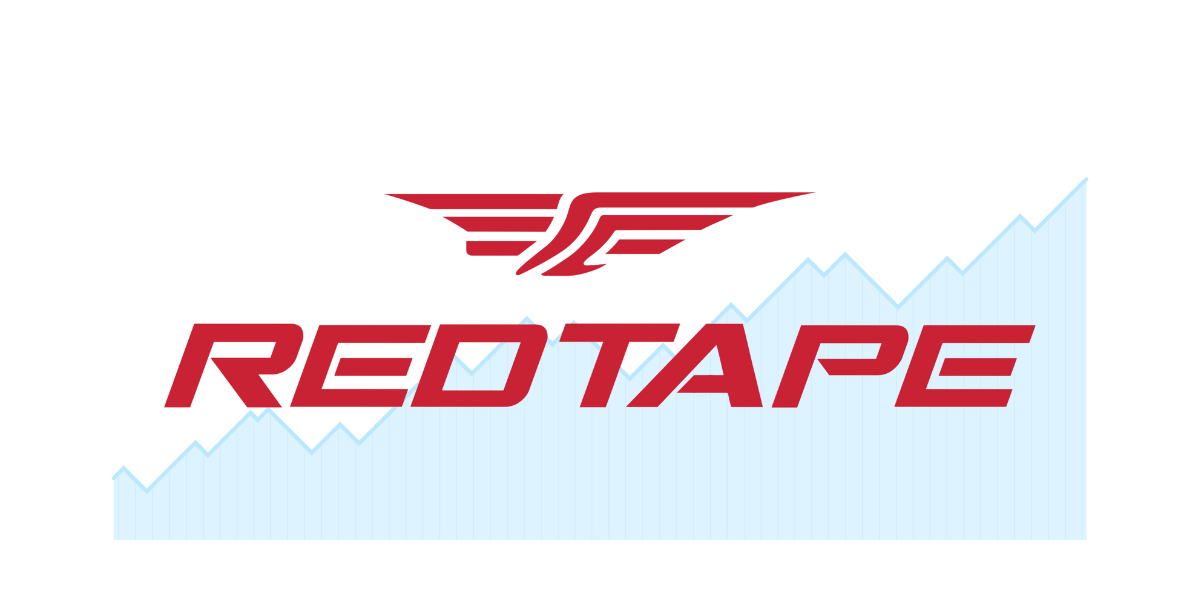Red Tape is an international fashion brand that offers trendy footwear, apparel, and accessories at competitive prices. The brand was founded in 1996 and is headquartered in India.
Disclosure: We are not associated with Redtape in any way. This guide is published only for educational purposes.
What’s covered in this guide:
The current state of the website
According to Semrush, RedTape gets around 1.3M organic visits every month. Seems like a great achievement in SEO.
But this is not the case.
Because more than 90% of traffic is coming from branded searches— that means the brand can rank for more high-buying intent keywords by ranking for non-branded keywords.
Branded search examples:
- Red tape shoes
- Redtape
- Redtape sneakers
Below, we have shared some SEO-winning strategies that will help RedTape expand its online business significantly.
Disclosure: I am not associated with Redtape in any way. This is published only for educational purposes.
Phase 1. SEO quick wins (low effort with high outcome)
1. Updating the meta title and description of category pages
One of the first things we will do is update the meta title and meta description of category pages.
Currently, these collection pages are not optimized for the right keyword and the description is not even optimised for SERP.
Here’s an example:
Another example of a collection page metadata:
There are a total of 163 collection pages.
The quickest way to optimize each of these pages with a unique title and description is by creating templates.
Here’s an example of a templatized meta title and description:
- TITLE→ Buy {category_name} For {Gender} – Starting at {₹ XXX}
- META DESCRIPTION→ Looking to buy the best quality {Gender}’s {category_name}? Check out Redtape’s stylish and durable {category_name} for {Gender} which is starting at only {₹ XXX}.
This way, we can optimize each category page with unique meta information.
Here’s an example of a templatized metadata of a collection page 👇
Collection page: Sports shoes for Men
- TITLE: Buy Sport Shoes For Men Online (Starting at only ₹840)
- META DESCRIPTION: Looking to buy the best quality Men’s sports shoes? Check out Redtape’s stylish and durable sports shoes for Men that are starting at only ₹840.
2. Unique content to the collection pages
Having unique relevant content on collection pages helps search engines understand more about the page and its products.
This is why we highly recommend adding unique content for each collection page optimized with internal links.
Here’s what we’d do:
- Create content briefs for collection pages
- Assign them to writers
- Edit the final content with internal links to relevant products or similar collection pages
However, we will also plan a pricing table on each collection page which looks like this:
The benefits?
Even though all of these sub-collection pages are linked from the header navigation, we still prefer to add them within the content of the page.
Why?
Because it passes more PageRank when added within the page’s main content as compared to header, footer, or sidebar.
Also, we can include different anchor text variations for internal linking.
3/ Update H1 tag of collection and product pages
Let’s first see the existing H1 structure of different pages:
- H1 tag of the collection page Men’s Footwear→ LATEST
- H1 tag of a product page → RTE3194B
As you can see, the H1 tags are not optimized at all for better search rankings and CTR.
Also, some pages even have 10+ H1 tags.
This can be easily fixed by replacing the existing H1 structure with the product name and collection page name.
4. Include ItemList schema on collection pages
By adding ItemList schema, we can markup each product in a list format (name, pricing, image URL, offers, etc.) and feed the information to search engines.
This will help search engines understand the page’s relevancy and product details.
Here’s a visual representation of ItemList schema:
Phase 2. Technical issues across the website
Many eCommerce websites rely on JavaScript to load products or make the pages dynamic based on the product category.
However, this can create some serious issues that affect the crawling and indexing of important pages of the website.
Here’s a real example from RedTape:
At first, the page might seem okay to you.
But the question is whether Google can crawl and index all links and content available on the page.
To check this, I have
- Pasted the page URL in the Rich Results Tester tool from Google.
- In the HTML code editor find a different product page URL that is visible to you.
As you can see in the rendered HTML version (the above screenshot), the product page URLs are not even visible to Google— that means Googlebot is not able to discover your page URLs.
💡 Note: Google can only see content that’s visible in the rendered HTML.
So, making the URLs and page content unavailable in the rendered HTML could be a huge missed opportunity for RedTape.
Phase 3. Targeting long-tail keyword variations
Before we dive into the scope, let’s first understand the type of category pages created under Men’s footwear:
These pages are targeting keywords such as:
- Sport shoes for men
- Boots for men
- Casual shoes for men
- Formal shoes for men, and so on.
These search queries are relevant to the RedTape product offerings. However, these are also highly competitive because of broad keywords.
Another approach redTape should consider is creating long-tail variations of these pages:
For example, the following new sub-collection pages could be created for Sport shoes 👇
- Black sports shoes (by colour)
- Sports shoes under ₹1,000 (by budget)
- White Sports shoes (by colour)
- Running sport shoes (by use case)
This way, you can create dozens of new sub-category pages that target low-competitive keywords with high relevance.
Another reason for targeting these long-tail variations with a dedicated collection page is search intent.
Take a look at the SERP for the search query ‘Black sport shoes.’
There is no generic sports shoe page ranking. Instead, Google is ranking specific collection pages listing only black sports shoes.
Phase 4. Product page internal linking
The missed opportunity of RedTape’s product pages is not adding enough related products.
For example, some of the shoe product pages have only one internal link to a similar product page.
Example:
Ideally, each product page should list other products from the same shoe category.
This helps in:
- More dwell time
- Upsells
- Might increase your conversion rate by giving other options
- Allowing users to compare between shoes
- ⭐ Improving the crawling and passing PageRank 🔗 from one page to another
Breadcrumb issues
Also, the breadcrumbs of product pages need improvement.
For example, the below boot page shows the boots collection page within the breadcrumb.
Ideal link path for this product page:
🏠 Homepage > 📑 Boots collection page > 👞 Boot product page
Phase 5. Blog content strategy
Now, comes the blog content strategy. The following four types of essential content type for Retape are:
- Buying guides
- Best X products (listicle articles)
- Shoes size chart
After keyword research, there might be a lot of other opportunities for blog content.
But these four could be a good starting point for increasing topical authority and relevance for the website.
However, the biggest benefit is internal linking from blog pages to product and collection pages.
Here’s the structure to follow for blog internal linking.
That means, you can focus on building links to the blog content which will pass Pagerank to the money pages over time.
NOTE: There is no blog article published on the site— which is a missed opportunity for the brand. This blog strategy might not directly bring more customers but it will help rank other pages better.
Other important opportunities
Backlinks:
- Featured, HARO for driving homepage backlinks (effort level: easy-med)
- Getting featured in ‘Top X shoe brands’ articles by incentives or sponsored posts (effort level: easy)
- Encouraging small bloggers and influencers to share their RedTape experiences through Medium/Linkedin articles or YouTube videos
- Building backlinks to specific blog articles which will then pass the PageRank to other money pages
- Getting brands and founder’s success stories featured on startup media portals
Other tasks involved:
- Adding custom schema on the homepage and about page creating a sales and coupon code page— many people search for these terms when buying Redtape shoes online
- Improving product page content with FAQs and social proof for conversions
Running a technical SEO audit to find issues preventing crawling or indexing all pages
- Testing different titles and descriptions for high CTR
Having a process of auditing and improving pages with declined traffic in the last 3-6 months
- Improving the UX of product pages for conversions
ROI expectation
To compare the ROI, here’s an example from a similar competitor— Bacca Bucci.
They are driving almost half a million organic visits every month.
But the best part is that their 60% of traffic is coming from non-branded search queries such as:
- White sneakers for men
- Sneakers
- Formal shoes
And their traffic cost is almost $20.6k which is almost $7k more than RedTape even getting more organic visits every month.
💡 NOTE: Traffic cost = The estimated average monthly cost to rank for organic keywords in Google Ads. The higher, the better.
Bacca Bucci’s traffic value is $6.7K more than RedTape’s traffic value because they are ranking for more branded search keywords.
This gives an idea of how much RedTape can increase its business revenue if it starts SEO and ranks for other non-branded keywords.
Here’s a typical timeframe that the RedTape team can consider for ROI:



